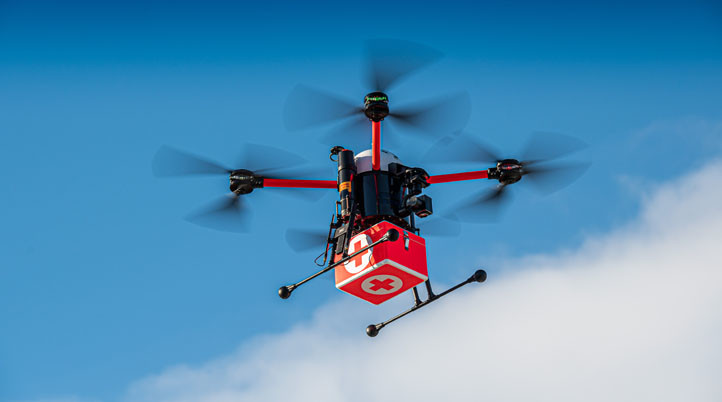Earlier this year, Hamburg’s joint research project Medifly conducted a total of six drone flights between the German Armed Forces Hospital in Wandsbek-Gartenstadt and Saint Mary’s Hospital in Hohenfelde, to explore how far UAVs can deliver medical samples safely and reliably.
Due to traffic, non-linear roads, and a distance of 5 km between the two hospitals, driving an ambulance can take twenty minutes at best or, at worst, surgical procedures may only continue a few days later. For example, since most hospitals don’t have their own pathology labs, surgeries can take more time than expected because of ambulances’ travel time and subsequent pathological analysis, leaving patients in anesthesia during that time. Moreover, the procedure may have to be repeated when analysis results indicate that removal of pathological tissue was not complete.
On the other hand, a drone’s flight path is largely uncontested by other traffic, therefore traveling the same distance in less time. To test this, Medifly flew a 10 kg special drone from Globe UAV attached with a tissue dummy. At an altitude of 75 meters and a speed of 40 km/h—although 80 km/h would not be a problem in real operation—the drone traveled the 5 km distance in only ten minutes, proving to be significantly faster than an ambulance.
However, flying a drone over a densely populated urban area and, in this case, in the air traffic control zone of Hamburg’s international airport required a large number of safety measures. Joined by ZAL Center of Applied Aeronautical Research, GLVI Gesellschaft für Luftverkehrsinformatik, Lufthansa Technik AG, and FlyNex, project Medifly invested several months of discussions and thorough planning between all parties to obtain the required flight approvals from the responsible authorities. In the end, all flights were automated, with additional remote pilots set up along the route to intervene at any time in an emergency.
“In this project, the specific benefit for both users and the community is clearly visible. Automated aerial vehicles will contribute significantly to the improvement of health care,” said Michael Westhagemann, Hamburg's Senator for Economics, Transport and Innovation.
“Medifly is not a classic aviation topic”, said Christian Caballero, Chief Operating Officer at FlyNex. “The mass of influencing factors for successful flight planning results from the ground infrastructure. With our solutions, we can also set the course for automated flights out of sight for this project and show how medical drones can support health care.”
FlyNex, a digital solutions provider for commercial drone operations, was responsible for eliminating all risks and ensuring a safe flight. It provided its digital maps, took care of the flight planning, and coordinated the permits with the aviation authorities. The company is continuously expanding its map rooms and flight software for medical and other missions.
Funded by the German Federal Ministry for Transportation and Digital Infrastructure (BMVI), Medifly came to life to answer two questions: Can flights be safely conducted in urban airspace? Do unmanned aircraft offer a significant reduction in transport time as compared to driving ambulances through urban road traffic?
Over the course of several months, the project plans to change the mode of operations from observers in the field to completely automatic operations, while monitoring the duration of flights, cost of operations, and availability of services, to assess commercial viability under the premises of patient health and flight safety.















Comments